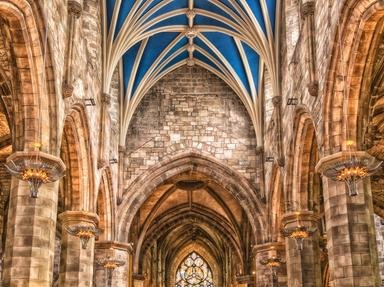Quiz Answer Key and Fun Facts
1. Let us start our tour from the Île de la Cité in Paris, where the Cathedral of Notre-Dame also stands. This much smaller place of worship with royal connections is renowned for its gorgeous 13th-century stained glass windows.
2. This impressive photo shows the intricately carved facade of another cathedral dedicated to Notre-Dame - an imposing building that was depicted by Claude Monet in a series of 30 celebrated paintings. In what northern French city, where Joan of Arc was burned at the stake in 1431, can it be found?
3. Now we are moving southeast to one of France's neighbouring countries. Built in the late Gothic style, this huge cathedral - one of the world's largest churches - took almost 600 years to complete. It now graces the centre of which major city, known as one of the world's fashion capitals?
4. This stately, two-level basilica is surrounded by the lovely countryside of the central Italian region of Umbria. Listed as a UNESCO World Heritage site, it is visited by millions of people every year, both for religious and cultural reasons. To which beloved saint, venerated as the patron of animals, is it dedicated?
5. With its soaring twin towers, the magnificent Cathedral of St Mary dominates the skyline of the historic city of Burgos in northern Spain, known for its connection with one of the country's national heroes, El Cid. In which historic region (where the Spanish language also originated) is Burgos found?
6. This photo captures the serene beauty of the cloister of the Monastery of Batalha. This splendid World Heritage site is probably the most celebrated Gothic building found in which western European country - a former colonial power known for its heady wines and beautiful beaches?
7. England is renowned for its wealth of Gothic architecture. This religious building, located in a celebrated place of learning, is one of the finest examples of the Perpendicular style. Built in a period that spanned the War of the Roses, it boasts magnificent stained glass windows and the world's largest fan vault.
8. The photo shows a spectacular view of the floodlit steeple of Ulm Minster, long the tallest church in the world. This southwestern German city is the birthplace of what great scientist, who won the 1921 Nobel Prize in Physics?
9. With its tall spire and polychrome-tiled roof, the stunning Matthias Church - named after one of the country's most influential kings - overlooks the Danube on a hill in the historic district of which majestic central European capital?
10. This lovely wintertime photo depicts a cathedral built in a less ornate style than the churches featured in the previous question. In which city, Finland's oldest and the country's former capital, is it located?
Source: Author
LadyNym
This quiz was reviewed by FunTrivia editor
trident before going online.
Any errors found in FunTrivia content are routinely corrected through our feedback system.
